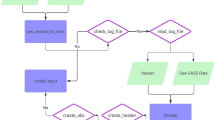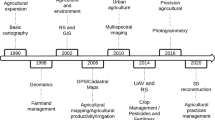Abstract
The digital elevation model (DEM) is considered by many to be an important base map for a precision farming GIS (Geographic Information System). Previous work has shown that dual-frequency survey grade GPS (Global Positioning System) receivers are capable of rapidly producing accurate positional data from a moving vehicle from which DEM's can be developed. However, this type of GPS receiver is expensive and somewhat difficult to use properly. This paper presents the results of a study to evaluate the potential of using single frequency sub-meter and 2–5 meter horizontal accuracy GPS receivers to enable the farmer to collect multiple passes of GPS data during normal field operations from which DEM's can be developed. The results show that when using a single frequency sub-meter GPS receiver: (1) it is possible to develop a DEM with standard deviation of the elevation accuracy on the order of 0.12–0.14 m, (2) in order to collect data with this level of elevation accuracy, data should only be collected when the GDOP (Geometric Dilution Of Precision) is less than 5.0, (3) at least 10 passes of data with appropriate data averaging is required to produce this level of elevation accuracy. The results also indicate that the vertical error associated with a 2–5 meter horizontal accuracy GPS receiver is such that it is not recommended for use in collecting data to develop DEM's in this application.
Similar content being viewed by others
References
R. L. Clark and R. Lee. Development of topographic maps for precision farming with kinematic OPS. Transactions of the ASAE 414, 909-916 (1998). Leica, GPS-SYSTEM 300, dual frequency GPS surveying and SKI documentation Leica, Inc., Norcross, GA, (1995).
Quicksurf, Version 5.1 for AutoCAD release 12, 13, 14, and FelixCAD surface modeling (Schreiber Instruments, Inc., Englewood, CO, 1998).
J. J. Spilker, Jr. in Global Positioning System: Theory and Applications, vol. I, edited by B. W. Parkinson and J. J. Spilker, Jr., Vol. 163, Progress in Astronautics and Aeronautics (American Institute of Aeronautics and Astronautics, Inc., 370 L'Enfant Promenade, Washington, DC, USA, 1996), pp. 177-208.
Surfer, Surface mapping system (Golden Software, Inc., Golden, CO, USA, 1996).
L. Y. Kettle and C. L. Peterson, An evaluation of yield monitors and GPS systems on hillside combines operating on steep slopes in the Palouse. ASAE Paper No. 98-1046 ASAE, St. Joseph, MI, USA, (1998).
Y. Lu, C. Daughtry,, and G. Hart, The current state of precision farming. Food Reviews International 132, 141-162 (1997).
D. S. Long, R. E. Engel, and G. R. Carlson. Maximizing protein and profits in Montana's Golden Triangle. Precision Farming: Supplement to GPS World Magazine August 24-28, (1997).
C. Yang, C. L. Peterson, G. J. Shropshire, and T. Otawa, Spatial variability of field topography and wheat yield in the Palouse region of the Pacific Northwest. Transactions of the ASAE 411, 17-27 (1998).
Author information
Authors and Affiliations
Rights and permissions
About this article
Cite this article
Yao, H., Clark, R.L. Evaluation of Sub-Meter and 2 to 5 Meter Accuracy GPS Receivers to Develop Digital Elevation Models. Precision Agriculture 2, 189–200 (2000). https://doi.org/10.1023/A:1011429815226
Issue Date:
DOI: https://doi.org/10.1023/A:1011429815226




